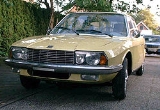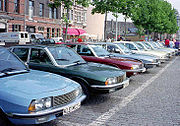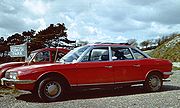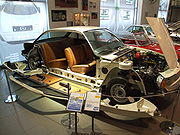
NSU Ro 80
Encyclopedia
The NSU Ro 80 was a technologically advanced large sedan-type automobile
produced by the German
firm of NSU
from 1967 until 1977. Most notable was the powertrain; a 113 bhp, 995 cc twin-rotor Wankel engine
driving the front wheels through a semi-automatic transmission
employing an innovative vacuum system. It was voted Car of the Year
for 1968 by European motoring writers.
Unfortunately for NSU, the car developed an early reputation for unreliability, from which it would never escape. The Ro80 engine in particular suffered from construction faults, among many other problems, and some early cars required a rebuilt engine before 30,000 miles (50,000 km), with problems visible as early as 15,000 miles (24,000 kilometres). The three-piece rotor tip seals were made out of the same material. The design fault caused the center section to have higher abrasion at cold starts than the corner pieces and the tip seals could push together, allowing the gas to blow past. With a changed tip seal design this was temporarily solved and with a tip seal center piece made of Ferrotic
, the problem was entirely resolved. The fact that the rotary engine design was inherently thirsty (typically 15-18 mpg) and a poor understanding of the Wankel engine by dealers and mechanics did not help this situation. By the 1970 model year
, most of these problems were resolved, but a necessarily generous warranty policy and damage to the car's reputation had undermined NSU's financial situation irreparably. NSU was acquired by Audi
(of the Volkswagen
group) in 1969.
Second hand Ro80s were virtually worthless in the 1970s due to the well-publicised engine problems, and a common "cure" for an ailing rotary engine was to simply swap it for a Ford V4 "Essex" engine (as found in Mk1 Transits) since it was one of the few engines compact enough to fit in the Ro80's engine bay. Thus in an ironic twist, one of the smoothest engines in the world was replaced by one of the roughest.
The NSU's unpopularity caused by the above problems means that surviving examples are very rare, and are now considered highly-prized classic cars with values to match, particularly thanks to Mazda
's perseverance with rotary design, the tip seal problem has been all but eradicated.


 Other technological features of the Ro80, aside from the powertrain, were the four wheel ATE Dunlop disc brakes, which for some time were generally only featured on expensive sports or luxury saloon cars. The front brakes were mounted inboard, reducing the unsprung weight
Other technological features of the Ro80, aside from the powertrain, were the four wheel ATE Dunlop disc brakes, which for some time were generally only featured on expensive sports or luxury saloon cars. The front brakes were mounted inboard, reducing the unsprung weight
. The suspension was independent on all four wheels, with MacPherson strut
s at the front and semi-trailing arm suspension at the rear, both of which are space-saving designs commonly used today. Power assisted ZF
rack and pinion
steering was used, again foreshadowing more recent designs.
The car featured an automatic clutch which was commonly described as a three-speed semi-automatic gearbox: there was no clutch pedal, but instead, on top of the gearknob, an electric switch that operated a vacuum system which disengaged the clutch. The gear lever itself then could be moved through a standard 'H pattern' gate.
Interior trim combined cloth covered seats with PVC headlining and a carpeted floor.
The styling, by Claus Luthe
who was head of design at NSU and later BMW, was considered very modern at the time and still holds up well; the Ro 80 has been part of many gallery exhibits of modern industrial design. The large glass area foreshadowed 1970s designs such as Citroën
's. The shape was also slippery, with a drag coefficient
of 0.355 (very good for the era, although average for modern cars). This allowed for a top speed of 112 mi/h. Indeed, comparisons have been drawn between the design of the Ro80 and the superbly aerodynamic 1982 Audi 100 - the shape is very similar.
Series production started in October 1967: the last examples came off the production line in April 1977. There were 37,204 vehicles produced during the ten year production run.
Automobile
An automobile, autocar, motor car or car is a wheeled motor vehicle used for transporting passengers, which also carries its own engine or motor...
produced by the German
Germany
Germany , officially the Federal Republic of Germany , is a federal parliamentary republic in Europe. The country consists of 16 states while the capital and largest city is Berlin. Germany covers an area of 357,021 km2 and has a largely temperate seasonal climate...
firm of NSU
NSU Motorenwerke AG
NSU Motorenwerke AG, normally just NSU, was a German manufacturer of automobiles, motorcycles and pedal cycles, founded in 1873. It was acquired by Volkswagen Group in 1969...
from 1967 until 1977. Most notable was the powertrain; a 113 bhp, 995 cc twin-rotor Wankel engine
Wankel engine
The Wankel engine is a type of internal combustion engine using an eccentric rotary design to convert pressure into a rotating motion instead of using reciprocating pistons. Its four-stroke cycle takes place in a space between the inside of an oval-like epitrochoid-shaped housing and a rotor that...
driving the front wheels through a semi-automatic transmission
Semi-automatic transmission
A semi-automatic transmission is an automobile transmission that does not change gears automatically, but rather facilitates manual gear changes by dispensing with the need to press...
employing an innovative vacuum system. It was voted Car of the Year
Car of the Year
Car of the Year is a phrase usually considered to have been invented by Motor Trend magazine in the 1950s for their annual award for best American automobile...
for 1968 by European motoring writers.
Unfortunately for NSU, the car developed an early reputation for unreliability, from which it would never escape. The Ro80 engine in particular suffered from construction faults, among many other problems, and some early cars required a rebuilt engine before 30,000 miles (50,000 km), with problems visible as early as 15,000 miles (24,000 kilometres). The three-piece rotor tip seals were made out of the same material. The design fault caused the center section to have higher abrasion at cold starts than the corner pieces and the tip seals could push together, allowing the gas to blow past. With a changed tip seal design this was temporarily solved and with a tip seal center piece made of Ferrotic
Titanium carbide
Titanium carbide, TiC, is an extremely hard refractory ceramic material, similar to tungsten carbide.It is commercially used in tool bits. It has the appearance of black powder with NaCl-type face centered cubic crystal structure...
, the problem was entirely resolved. The fact that the rotary engine design was inherently thirsty (typically 15-18 mpg) and a poor understanding of the Wankel engine by dealers and mechanics did not help this situation. By the 1970 model year
Model year
The model year of a product is a number used worldwide, but with a high level of prominence in North America, to describe approximately when a product was produced, and indicates the coinciding base specification of that product....
, most of these problems were resolved, but a necessarily generous warranty policy and damage to the car's reputation had undermined NSU's financial situation irreparably. NSU was acquired by Audi
Audi
Audi AG is a German automobile manufacturer, from supermini to crossover SUVs in various body styles and price ranges that are marketed under the Audi brand , positioned as the premium brand within the Volkswagen Group....
(of the Volkswagen
Volkswagen
Volkswagen is a German automobile manufacturer and is the original and biggest-selling marque of the Volkswagen Group, which now also owns the Audi, Bentley, Bugatti, Lamborghini, SEAT, and Škoda marques and the truck manufacturer Scania.Volkswagen means "people's car" in German, where it is...
group) in 1969.
Second hand Ro80s were virtually worthless in the 1970s due to the well-publicised engine problems, and a common "cure" for an ailing rotary engine was to simply swap it for a Ford V4 "Essex" engine (as found in Mk1 Transits) since it was one of the few engines compact enough to fit in the Ro80's engine bay. Thus in an ironic twist, one of the smoothest engines in the world was replaced by one of the roughest.
The NSU's unpopularity caused by the above problems means that surviving examples are very rare, and are now considered highly-prized classic cars with values to match, particularly thanks to Mazda
Mazda
is a Japanese automotive manufacturer based in Fuchū, Aki District, Hiroshima Prefecture, Japan.In 2007, Mazda produced almost 1.3 million vehicles for global sales...
's perseverance with rotary design, the tip seal problem has been all but eradicated.



Unsprung weight
In a ground vehicle with a suspension, the unsprung weight is the mass of the suspension, wheels or tracks , and other components directly connected to them, rather than supported by the suspension...
. The suspension was independent on all four wheels, with MacPherson strut
MacPherson strut
The MacPherson strut is a type of car suspension system which uses the axis of a telescopic damper as the upper steering pivot. It is widely used in modern vehicles and named after Earle S. MacPherson, who developed the design.-History:...
s at the front and semi-trailing arm suspension at the rear, both of which are space-saving designs commonly used today. Power assisted ZF
ZF Friedrichshafen
ZF Friedrichshafen AG, also known as ZF Group, and commonly abbreviated to ZF, is a German public company headquartered in Friedrichshafen, in the south-west German region of Baden-Württemberg....
rack and pinion
Rack and pinion
A rack and pinion is a type of linear actuator that comprises a pair of gears which convert rotational motion into linear motion. A circular gear called "the pinion" engages teeth on a linear "gear" bar called "the rack"; rotational motion applied to the pinion causes the rack to move, thereby...
steering was used, again foreshadowing more recent designs.
The car featured an automatic clutch which was commonly described as a three-speed semi-automatic gearbox: there was no clutch pedal, but instead, on top of the gearknob, an electric switch that operated a vacuum system which disengaged the clutch. The gear lever itself then could be moved through a standard 'H pattern' gate.
Interior trim combined cloth covered seats with PVC headlining and a carpeted floor.
The styling, by Claus Luthe
Claus Luthe
Claus Luthe, was an important German car designer, responsible for the NSU Ro 80 as well as a number of Audi and BMW models...
who was head of design at NSU and later BMW, was considered very modern at the time and still holds up well; the Ro 80 has been part of many gallery exhibits of modern industrial design. The large glass area foreshadowed 1970s designs such as Citroën
Citroën
Citroën is a major French automobile manufacturer, part of the PSA Peugeot Citroën group.Founded in 1919 by French industrialist André-Gustave Citroën , Citroën was the first mass-production car company outside the USA and pioneered the modern concept of creating a sales and services network that...
's. The shape was also slippery, with a drag coefficient
Drag coefficient
In fluid dynamics, the drag coefficient is a dimensionless quantity that is used to quantify the drag or resistance of an object in a fluid environment such as air or water. It is used in the drag equation, where a lower drag coefficient indicates the object will have less aerodynamic or...
of 0.355 (very good for the era, although average for modern cars). This allowed for a top speed of 112 mi/h. Indeed, comparisons have been drawn between the design of the Ro80 and the superbly aerodynamic 1982 Audi 100 - the shape is very similar.
Series production started in October 1967: the last examples came off the production line in April 1977. There were 37,204 vehicles produced during the ten year production run.
See also
- ComotorComotorThe Company Comotor SA was a joint venture between NSU and Citroën, created in Luxembourg in April 1967. Its goal was to produce Wankel engines....
- Citroën GS Birotor
- NSU SpiderNSU SpiderThe NSU Spider was the first production car in the world to be powered by a Rotary Wankel engine.Apart from its water-cooled single rotor engine, the car was in most respects unremarkable...
: the Spider had been the world's first Wankel engined production car
External links
- http://www.ro80.nl
- http://www.nsu-ro80.de
- http://www.nsu.nl
- http://www.nsu.be

